
книга / 2016_Kaplan_USMLE_Step_1_Lecture_Notes_Pharmacology
.pdf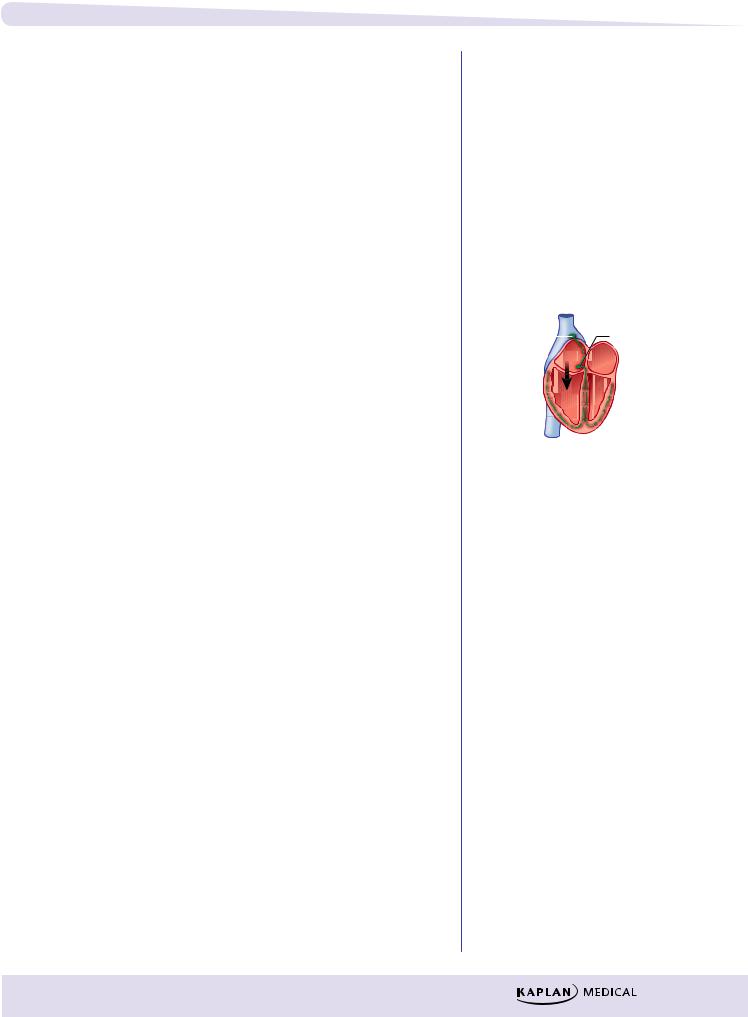
λDigoxin
−Direct effect: inhibition of cardiac Na+-K+ ATPase
ºResults in ↑ intracellular Na+
º↓ Na+/Ca2+ exchange
º↑ intracellular Ca2+
º↑ Ca2+ release from sarcoplasmic reticulum
º↑ actin-myosin interaction
º↑ contractile force
−Indirect effect: inhibition of neuronal Na+-K+ ATPase
ºResults in ↑ vagal activity
−Pharmacokinetics:
ºLong t1/2: need loading dose (LD)
ºRenal clearance: caution in renal impairment
ºTissue protein binding (large Vd): displacement by other drugs (verapamil, quinidine)
−Uses:
ºCHF
ºSupraventricular tachycardias, except Wolff-Parkinson-White syndrome (see margin note)
−Side effects:
ºEarly signs include anorexia, nausea, ECG changes
ºLater signs include disorientation, visual effects (halos)
ºIn toxic doses, any cardiac arrhythmias
−Management of toxicity
ºUse of Fab antibodies toward digoxin
ºSupportive therapy (electrolytes and antiarrhythmics class IB)
−Drug interactions:
ºDiuretics: ↓ K+, ↓ Mg2+, ↑ Ca2+
ºQuinidine and verapamil
λPhosphodiesterase inhibitors: inamrinone and milrinone
−Use: acute CHF only
−↑ cAMP in heart muscle; results in ↑ inotropy
−↑ cAMP in smooth muscle; results in ↓ TPR
λSympathomimetics: dobutamine and dopamine
−Use: acute CHF only
OTHER DRUGS
−Nesiritide
ºRecombinant form of human B-type natriuretic peptide (rh BNP)
ºBinds to natriuretic peptide receptors, thus ↑ cGMP, resulting in vasodilation
ºUsed in acutely decompensated CHF
Chapter 3 λ Drugs for Heart Failure
Note
Wolff-Parkinson-White Syndrome
SA node |
|
|
AV node |
|
|
||
Conduction |
|
|
|
accessory |
|
(Slow |
|
|
|||
pathways |
|
||
(fast |
|
conduction) |
|
muscle |
|
|
|
fibers) |
|
|
|
λDo:
–block accessory pathway with IA or III
λDon’t:
–slow AV conduction (avoid digoxin, β-blocker, Ca2+-channel blocker, adenosine)
Clinical Correlate
Diastolic dysfunction (CHF with preserved ejection fraction) is best treated with β blockers and diuretics.
99

Section III λ Cardiac and Renal Pharmacology
Chapter Summary
λHeart failure is an inability of the heart to pump with sufficient vigor to maintain an adequate cardiac output. The mechanisms involved are discussed and are illustrated in Figure III-3-1.
λDrugs used to treat heart failure include those that decrease preload (e.g., diuretics, ACEIs, ARBs, and venodilators), those that decrease afterload (e.g., ACEIs, ARBs, and arteriodilators), and those that increase cardiac contractility (e.g., digoxin and beta agonists).
λPrimary treatments for chronic CHF are ACEI, beta blockers, and diuretics.
λDrugs which inhibit cardiac remodeling include ACEI, ARBs, beta blockers, spironolactone, and eplerenone.
λDigoxin enhances cardiac contraction by inducing a series of responses initiated by inhibiting the Na+/K+ ATPase. Figure III-3-2 shows how inhibition of cardiac membrane Na+/K+ ATPase leads to increased contractility.
λDigoxin has potential toxic effects that are in part dependent upon the electrolyte balance.
λBipyridines, sympathomimetics, and nesiritide also have uses in treating acute heart failure.
100
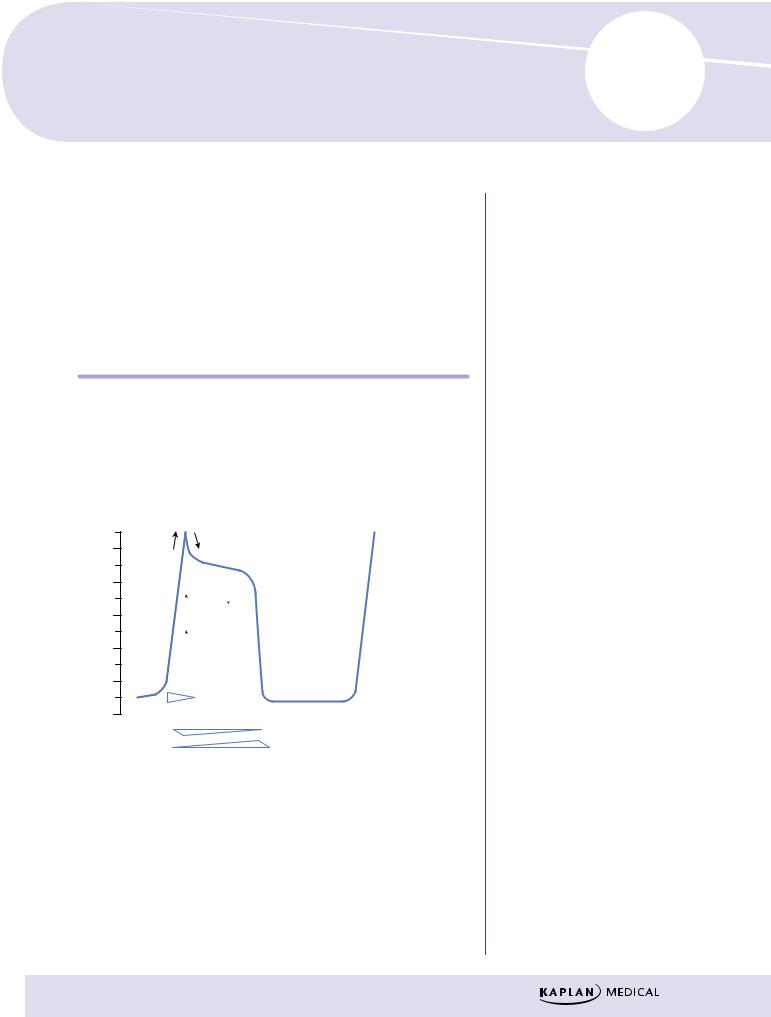
Antiarrhythmic Drugs |
4 |
Learning Objectives
Demonstrate understanding of cardiac action potential
Use knowledge of Na+ channels to explain arrhythmias,
Explain information related to ANS regulation of heart rate
Answer questions about controlling arrhythmias using Na+ channel blockers, beta blockers, K+ channel blockers, Ca2+ channel blockers, and other unclassified drugs
CARDIAC ACTION POTENTIAL
Fast-Response Fibers: Cardiac Muscle, His-Purkinje
System
mV
0
−20
−40
−60
−80
−100
Overshoot (phase 1)
) |
|
Plat |
|
|
|
||||
|
|
|
|
|
e |
|
|
|
|
0 |
( |
|
|
|
a |
u |
|
||
se |
|
|
|
|
|
|
|
||
|
p |
as |
|
|
|
|
|
||
|
|
|
h |
e |
|
|
|
||
pha |
|
|
|
|
2) |
|
|
||
|
Ca |
2+ |
|
|
K |
+ |
|
||
|
|
|
|
||||||
( |
|
|
|
|
|
|
|||
n |
|
|
|
|
|
|
n |
|
|
o |
|
|
|
|
|
|
i |
|
|
ti |
|
|
|
|
|
|
o |
) |
|
|
|
|
|
|
|
t |
|||
za |
|
|
|
|
|
|
|
||
|
|
|
|
|
|
i e |
|||
|
|
Na |
+ |
|
|
|
a |
3 |
|
i |
|
|
|
|
z |
s |
|||
|
|
|
|
|
r |
||||
r |
|
|
|
|
|
|
|
|
|
ola |
|
|
|
|
|
|
a |
|
|
|
|
|
|
|
|
|
|
l a |
|
p |
|
|
|
|
|
|
|
o h |
|
|
|
|
|
|
|
|
p p |
||
e |
|
|
|
|
|
|
|
||
|
|
|
|
|
|
|
e |
( |
|
D |
|
|
|
|
|
|
|
||
|
|
|
|
|
|
|
R |
|
|
|
|
|
|
|
|
|
|
|
|
Fast Na+ current
 K+
K+
Resting potential
(phase 4)
Slow Ca2+ current Delayed rectifier K+ current
Figure III-4-1. Cardiac Action Potentials in Fast-Response Fibers
Phase 0
λNa+ channels open—sodium enters the cell down its concentration gradient (fast INa), causing membrane depolarization.
λRate of depolarization depends on number of Na+ channels open, which in turn depends on resting membrane potential of the cell.
λClass I antiarrhythmic drugs can slow or block phase 0 in fast-response fibers.
101

Section III λ Cardiac and Renal Pharmacology
Phase 1
λNa+ channels are inactivated.
λIn some His-Purkinje cells, transient outward K+ currents and inward Cl– currents contribute to the “notch” and overshoot.
λAntiarrhythmic drugs have no significant effects on these transient currents.
Phase 2
λPlateau phase in which a slow influx of Ca2+ (ICa-L) is “balanced” by a late-appearing outward K+ current (the delayed rectifier current IK).
λAntiarrhythmic drugs have no significant effects on these currents during this phase of the action potential (AP).
Phase 3
λRepolarization phase in which the delayed rectifier K+ current rapidly increases as the Ca2+ current dies out because of time-dependent channel inactivation.
λClass III antiarrhythmic drugs slow this repolarization phase.
λNote that during phases 0 through 3 a slow Na+ current (“window current”) occurs, which can help prolong the duration of the action potential.
Phase 4
λReturn of membrane to resting potential—maintained by activity of the Na+/K+-ATPase.
Responsiveness
λCapacity of a cell to depolarize, associated with the number of Na+ channels in a ready state (see Figure III-4-4).
λThis in turn depends on resting membrane potential: the more negative the resting potential (RP), the faster the response.
Conductance
Rate of spread of an impulse, or conduction velocity—three major determinants:
λRate of phase 0 depolarization—as Vmax decreases, conduction velocity decreases and vice versa.
λThreshold potential—the less negative, the slower the conduction velocity.
λResting potential—the more negative the RP, the faster the conduction.
102
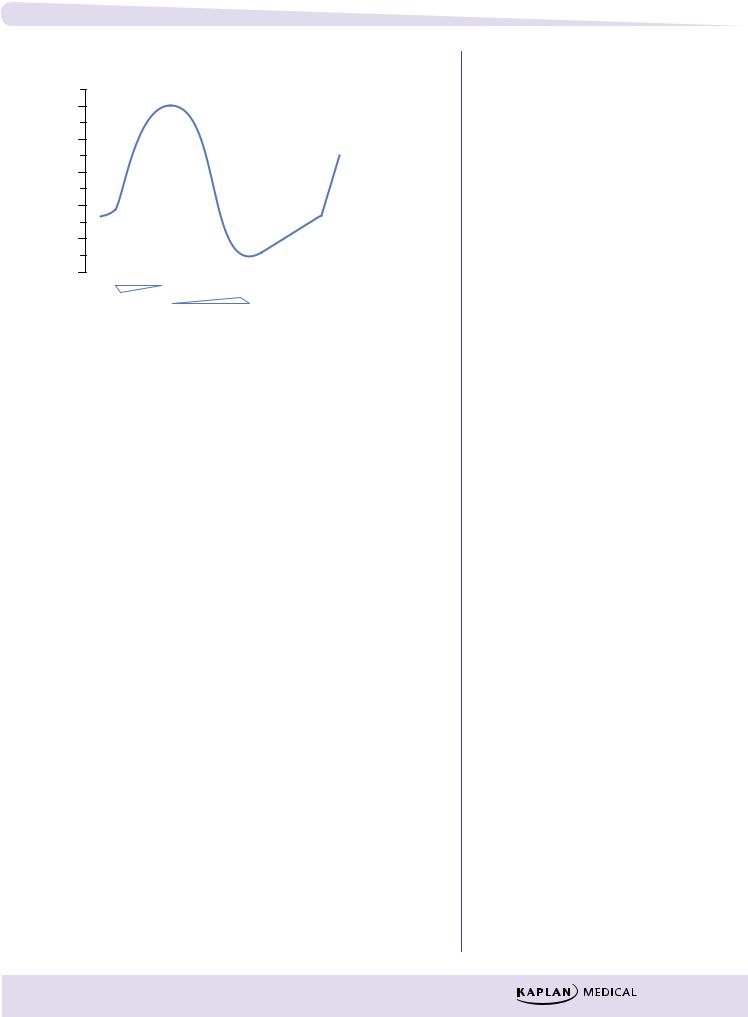
Chapter 4 λ Antiarrhythmic Drugs
Slow-Response Fibers (SA and AV Nodes, Specialized Cells)
0
−20
−40
−60
−80
−100
↓ K+
↑ Ca2+
Pacemaker
current
↑ Na+, ↑ Ca2+: ↓ K+
Slow Ca+ current
Delayed rectifier K+ current
Figure III-4-2. Cardiac Action Potentials in Slow-Response Fibers
λNo appreciable Na+ current during phase 0 in these cells because the Na channels are either absent or in an inactive form because of the existing voltage.
λDepolarization depends on activation of Ca2+ channels (ICa-L and ICa-T).
λClass IV antiarrhythmic drugs can slow or block phase 0 in slowresponse fibers.
λDuring repolarization, the Ca2+ currents are opposed and overcome by the delayed rectifier K+ current. The relative magnitudes of these opposing currents determine the “shape” of the action potential.
λThe major distinctive feature of slow fibers is their spontaneous depolarization, shown by the rising slope of phase 4 of the AP, referred to
as the pacemaker potential or “pacemaker current.” Although not completely understood, pacemaker potential is a composite of inward Na+ (If) and Ca2+ (ICa-T) currents and outward K+ currents (IK).
λClass II and IV antiarrhythmic drugs can slow phase 4 in pacemaker fibers.
Automaticity
λThe ability to depolarize spontaneously confers automaticity on a tissue.
λThe fastest phase 4 slope will determine the pacemaker of the heart, which is normally the SA node.
Refractoriness
λ The inability to respond to a stimulus—property of all cardiac cells.
103
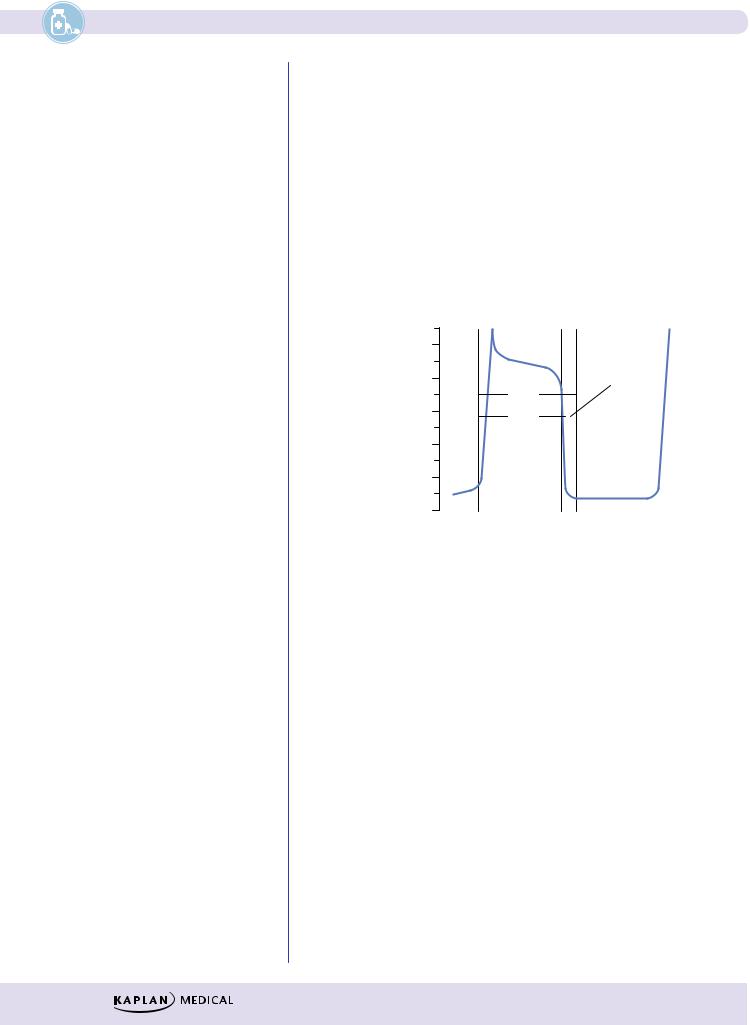
Section III λ Cardiac and Renal Pharmacology
Effective Refractory Period (ERP)
λNo stimulus, of any magnitude, can elicit a response.
λLasts into late stage 3 of the AP because Na+ channels are effectively inactivated and not in the “ready” state.
λBlockers of K+ channels prolong the ERP.
Relative Refractory Period (RRP)
λA strong stimulus can elicit a response, but the timing will be out of sync with the rest of the heart and arrhythmias may occur.
λRatio of ERP to the action potential duration (APD) is a measure of refractoriness, as illustrated in Figure III-4-3. Decreases in ERP favor the formation and propagation of premature impulses.
mV
0
−20
−40
−60
−80
−100
RRP
APD
ERP
Figure III-4-3. Relationship of ERP to APD
104
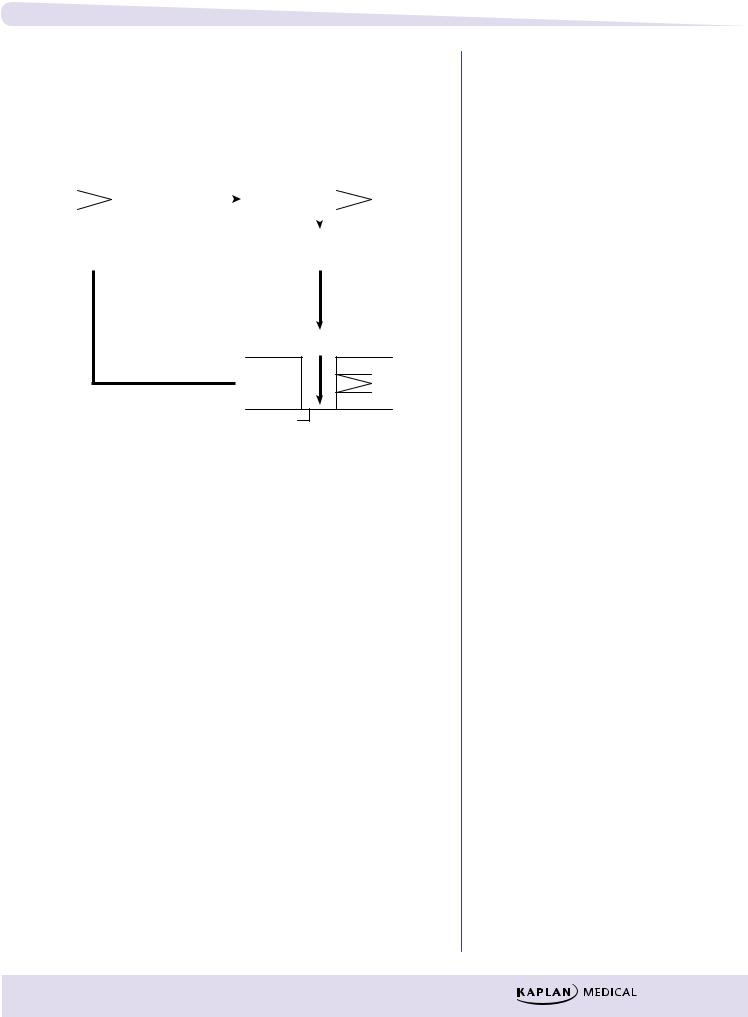
Chapter 4 λ Antiarrhythmic Drugs
Na+ CHANNELS
Activation
Resting, Ready |
|
Open, Active |
Na+ |
||||||||||
|
Phase 0, Na+ in |
||||||||||||
|
|
|
|
|
|
|
|||||||
|
|
|
|
|
|
|
|
|
|
|
|
|
|
|
|
Closed |
Threshold |
|
|
|
|
Open |
|||||
|
|
|
|
|
|
||||||||
|
|
|
|
|
|
|
|
|
|
||||
|
|
gate opens |
|
|
|
|
|||||||
|
|
|
|
|
|
|
|
|
|
||||
|
|
|
|
|
|
|
|
|
|
|
|
|
|
|
|
|
|
|
|
|
|
|
|
|
|
|
|
|
|
|
Open |
|
|
|
|
|
|
|
Open |
||
|
|
|
|
|
|
|
|
|
|
|
|
|
|
|
|
|
|
|
|
|
|
|
|
|
|
|
|
 Na/K ATPase pump is active.
Na/K ATPase pump is active.
3 Na out/2 K in, helps repolarization At approx. –50mV ‘M’ gate closes. At approx. –85mV ‘h’ gate opens.
Depolarization of tissue
|
Inactive Refractory |
Repolarization |
Open |
|
|
|
Closed |
Figure III-4-4. Mechanism of Action of Voltage-Gated Na+ Channels
λThis voltage-gated channel, which is responsible for the fast Na current (INa), exists in three conformations:
–Resting or ready state
–Open or active state
–Inactivated or refractory state
λThe channel has two gates: M (activating) and h (inactivating), both of which are sensitive to voltage changes.
λInactivation of the h gate is slower; therefore, it stays open longer and the Na channel is active.
Recovery
λRate of recovery of the Na channel is dependent on resting potential (RP).
λFastest rate of recovery occurs at normal RP, and recovery slows as membrane voltage increases.
λRate of recovery is slower in ischemic tissue because cells may be partly depolarized at rest. This reduces the number of channels able to participate in the next depolarization, which leads to a decrease in conduction rate in ischemic tissue.
λNa channel blockers also slow the rate of recovery in such tissues.
105

Section III λ Cardiac and Renal Pharmacology
Note
For the exam, you should understand which effect is antiarrhythmic (slows heart) and which is proarrhythmic (speeds up heart).
Note
Quinidine is a weak base, and antacids increase its absorption, thus greatly increasing its toxicity.
ANS REGULATION OF HEART RATE
λNodal tissue, especially that of the SA node, is heavily innervated by both PANS and SANS fibers activating M2 and β1 receptors, respectively.
λPhase 4 slope is increased by an increase in cAMP resulting from β1 receptor activation and slowed by a decrease in cAMP resulting from M2 receptor activation.
λIncrease in cAMP will:
–Increase upstroke velocity in pacemakers by increase of ICa-L
–Shorten AP duration by increase of IK
–Increase HR by increase of If , thus increasing slope of phase 4
λDecrease in cAMP:
–Does the opposite plus produces a K+ current (IK/ACh), which slows the rate of diastolic depolarization and thus decreases HR
–Beta blockers prevent cAMP formation, with primary effects on SA and AV nodal tissues.
CLASS I: Na+ CHANNEL BLOCKERS
Class 1A
λAntiarrhythmic: block fast Na+ channels (↓ INa)
λPreferentially in the open or activated state—“state-dependent” blockade
λ↑ action potential duration (APD) and effective refractory period (ERP)
λAlso blocks K+ channel (prolongs repolarization)
λDrugs:
–Quinidine
ºIn addition to the above, causes muscarinic receptor blockade, which can ↑ HR and AV conduction.
ºMay also cause vasodilation via alpha block with possible reflex tachycardia.
ºOrally effective, wide clinical use in many arrhythmias; in atrial fibrillation, need initial digitalization to slow AV conduction.
ºAdverse effects: cinchonism (GI, tinnitus, ocular dysfunction, CNS excitation), hypotension, prolongation of QRS and ↑ QT interval associated with syncope (torsades).
ºDrug interactions: hyperkalemia enhances effects and vice versa; displaces digoxin from tissue binding sites, enhancing toxicity.
–Procainamide
ºLess muscarinic receptor block
ºMetabolized via N-acetyltransferase (genotypic variation) to N-acetyl procainamide (NAPA), an active metabolite
ºAdverse effects: systemic lupus erythematosus (SLE)–like syndrome (30% incidence) more likely with slow acetylators; hematotoxicity (thrombocytopenia, agranulocytosis); CV effects (torsades)
106

Chapter 4 λ Antiarrhythmic Drugs
Class 1B
λAntiarrhythmic: block fast Na+ channels (↓ INa)
λBlock inactivated channels—preference for tissues partly depolarized (slow conduction in hypoxic and ischemic tissues). This results in an increased threshold for excitation and less excitability of hypoxic heart muscle.
λ↓ APD—due to block of the slow Na+ “window” currents, but this increases diastole and extends the time for recovery.
λDrugs and uses:
−Lidocaine
ºPost-MI
ºOpen-heart surgery
ºDigoxin toxicity
ºSide effects: CNS toxicity (seizures); least cardiotoxic of conventional anti-arrhythmics
ºIV use because of first-pass metabolism
−Mexiletine
ºSame uses as lidocaine
ºOral formulations
Class 1C
λBlock fast Na+ channels (↓ INa), especially His-Purkinje tissue
λNo effect on APD
λNo ANS effects
λDrug:
–Flecainide
ºLimited use because of proarrhythmogenic effects, leading to ↑ in sudden death post-MI and when used prophylactically in VT
CLASS II: BETA BLOCKERS
λPrevent β-receptor activation, which would normally ↑ cAMP
λ↓ SA and AV nodal activity
λ↓ Slope of phase 4 (diastolic currents) of AP in pacemakers
λDrugs:
–Propranolol (nonselective) and the cardioselective drugs: acebutolol and esmolol
–Uses:
ºProphylaxis post-MI and in supraventricular tachyarrhythmias (SVTs)
ºEsmolol (IV) is used in acute SVTs
107

Section III λ Cardiac and Renal Pharmacology
Clinical Correlate
Long QT Syndrome
A familial condition associated with increased risk of ventricular arrhythmias may result from mutation in the gene encoding cardiac potassium channels. Class IA and class III antiarrhythmic drugs may increase the risk of torsades in such patients.
Treatment of Torsade
λCorrect hypokalemia.
λCorrect hypomagnesemia.
λDiscontinue drugs that prolong the QT interval.
Clinical Correlate
Atrial fibrillation is the most common arrhythmia in the United States. The primary goals for treatment are:
1.ventricular rate control with beta blockers, CCBs, or digoxin; and
2.anticoagulation.
Clinical Correlate
Potassium
Both hyperkalemia and hypokalemia are arrhythmogenic.
CLASS III: K+ CHANNEL BLOCKERS
λ↓ IK (delayed rectifier current) slowing phase 3 (repolarization) of AP
λ↑ APD and ERP, especially in Purkinje and ventricular fibers
λDrugs:
−Amiodarone
ºMimics classes I, II, III, and IV
ºIncrease APD and ERP in all cardiac tissues
ºUses: any arrhythmias
ºt1/2 >80 days
ºBinds extensively to tissues (large Vd and multiple effects)
ºSide effects:
Pulmonary fibrosis
Blue pigmentation of the skin (“smurf skin”)
Phototoxicity
Corneal deposits
Hepatic necrosis
Thyroid dysfunction
−Sotalol:
º↓ IK, slowing phase III
ºNon-selective beta blocker: β1 blockade, leading to ↓ HR, ↓ AV conduction
ºUse: life-threatening ventricular arrhythmia
ºSide effects: torsades
CLASS IV: Ca2+ CHANNEL BLOCKERS
λBlock slow cardiac Ca2+ channels
λ↓ phase 0, ↓ phase 4
λ↓ SA, ↓ AV nodal activity
λDrugs:
−Verapamil and diltiazem
ºPrototype Ca2+-channel blockers (see Antihypertensive Drugs and Antianginal Drugs chapters in this section)
ºUses: supraventricular tachycardias
ºSide effects: constipation (verapamil), dizziness, flushing, hypotension, AV block
ºDrug interaction:
Additive AV block with β-blockers, digoxin
Verapamil displaces digoxin from tissue-binding sites
UNCLASSIFIED
λAdenosine
−Activates adenosine receptors: causes Gi-coupled decrease in cAMP
−↓ SA and AV nodal activity
108
